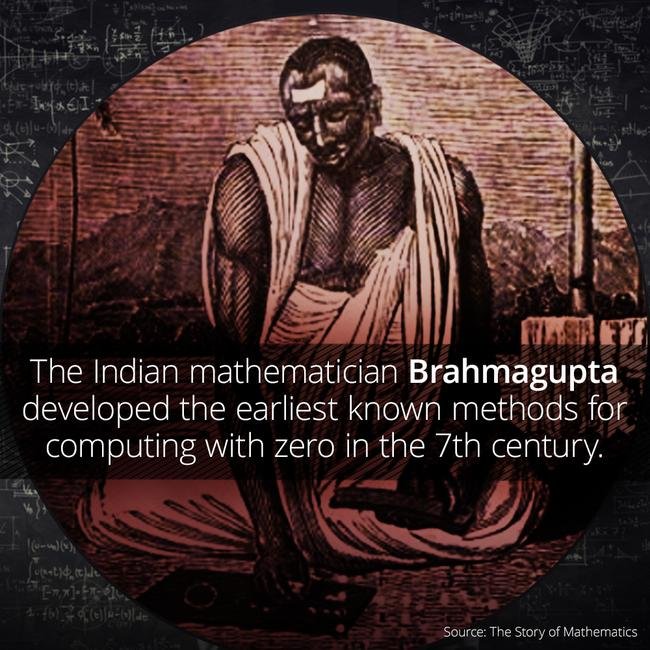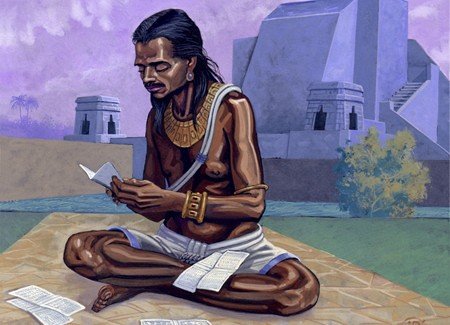Brahmagupta - A Father Of Ancient Indian Mathematics
Anil - Jun 19, 2019

Many of Brahmagupta's important discoveries were written not in mathematical equations, but in poetry!
- A Math Formula Tells Us How Long Everything Will Live
- Delhi Is The World’s Most Polluted Capital City For Three Years In A Row
- Indian Farmers Install High-Tech, Night-Vision CCTV Cameras To Protect Themselves
Brahmagupta was a mathematician and astronomer who lived in Ancient India from 597 AD to 668 AD. Born in Northwest India, Brahmagupta was a son of an astrologer.
Although Brahmagupta reportedly considered himself as an astronomical rather than a pure mathematician, there's not any doubt that his contribution to Ancient Indian mathematics is so important. It's kind of interesting to know that he solved difficult mathematical problems for pleasure. Brahmagupta created four books about mathematics and astronomy, of which the most famous work is "Brahma's Correct System of Astronomy" (Brahma-sphuta-Siddhanta in ancient Vedic language) - usually known as "The Opening of the Universe". The others are “Cadamakela”, “Durkeamynarda”, and "Khandakhadyaka" - a practical manual book of Indian Astronomy.

For your information, many of his important discoveries were written not in mathematical equations, but in poetry. Nevertheless, truth is the truth, regardless of how it may be written.
The Ancient Indian mathematician is so unique, thanks for his discovery of the properties of precisely zero. He was the first person in the world's history who defined the properties of the number zero. Considering it as a number with properties which needs to be defined has opened so much important chances for both mathematics and science until now. Brahmagupta defined zero as the number that you actually get when doing a subtract from a number to itself. He indicated that a zero divides any number always results in zero. (Unfortunately, he said 'any number' includes number zero).
Brahmagupta actually got wrong when he said that zero divided zero is zero, though this seems reasonable. Now, mathematicians have shown that there's really no answer to the result of the equation "zero divides zero". This is absolutely undefined and has no meaning.
Brahmagupta was also the first mathematician who discovered the formula for working with quadratic equations. This actually simplifies to Heron's formula for triangles.
Talking more about his mathematical contribution in arithmetic, the value of the number pi that he found out is about 0.66 percent higher than the true value of pi. He wrote that the ratio of a circle's circumference to its diameter (pi) could usually be taken to be 3, but if accuracy were needed, then the square root of 10 (approximately 3.162...).
Some rules for calculations of positive and negative numbers were established by Brahmagupta. Here're some fundamental rules that we have been using for decades:
- a negative number plus another negative number always result in a negative number.
- a positive number subtracts a negative number will have the same result when adding those two numbers.
- a negative number multiplies a negative number will have the same result when multiplying those numbers in positive forms.
- a positive number divides a negative number, or a negative number divides a positive number results in a negative one.

Brahmagupta was the director of the astronomical observatory in Ujjain, the center of Ancient Indian mathematical astronomy. Brahmagupta's astronomical knowledge about the Earth is pretty overwhelming at that time. To recall, all of them were not discovered by any telescope or scientific equipment. By using mathematics to predict the positions of the Earth and other planets, he discovered that the distance between the Moon and Earth is smaller than the distance between the Moon and Sun. He did correctly calculate that the Earth is a sphere of circumference around 36,000 km (appx 22,500 miles). Furthermore, Brahmagupta also indicated that a year lasts 365 days, plus 6 hours, 12 minutes, and even 9 seconds. However, He was wrong when saying that our Earth did not spin as well as it does not orbit the Sun. However, this might be for reasons of self-preservation. Opposing the Brahmins' religious myths of the time would have been dangerous.
Featured Stories

Features - Jul 01, 2025
What Are The Fastest Passenger Vehicles Ever Created?

Features - Jun 25, 2025
Japan Hydrogen Breakthrough: Scientists Crack the Clean Energy Code with...

ICT News - Jun 25, 2025
AI Intimidation Tactics: CEOs Turn Flawed Technology Into Employee Fear Machine

Review - Jun 25, 2025
Windows 11 Problems: Is Microsoft's "Best" OS Actually Getting Worse?

Features - Jun 22, 2025
Telegram Founder Pavel Durov Plans to Split $14 Billion Fortune Among 106 Children

ICT News - Jun 22, 2025
Neuralink Telepathy Chip Enables Quadriplegic Rob Greiner to Control Games with...

Features - Jun 21, 2025
This Over $100 Bottle Has Nothing But Fresh Air Inside

Features - Jun 18, 2025
Best Mobile VPN Apps for Gaming 2025: Complete Guide

Features - Jun 18, 2025
A Math Formula Tells Us How Long Everything Will Live

Features - Jun 16, 2025
Comments
Sort by Newest | Popular